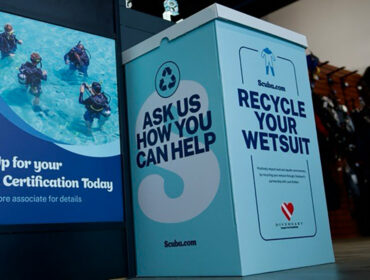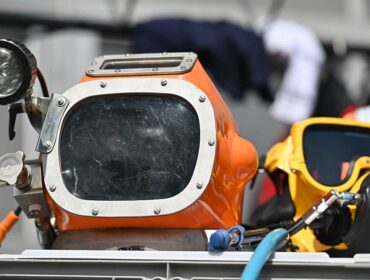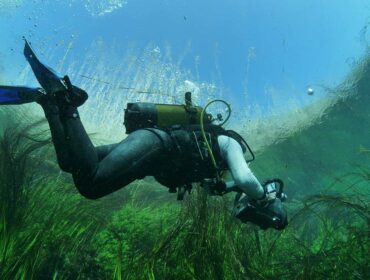When diving in waters cooler than your body temperature, it brings down your temperature. In even the warmest, tropical waters, you tend to need a bit of thermal protection to keep warm on long dives. Hence, the need to wear exposure protection like a wetsuit or dry suit. Another plus of wearing a wet or drysuit is that it provides your skin protection from the harsh sun, which divers seem not to notice when they are underwater but still affects our skin.
Here’s a closer look at Scuba Diving Exposure Protection and what you need to look for when buying any-
Rash Guard/ Skins
Either on the boat or above water while scuba diving, or when performing any kind of water sport, a rash guard is the best form of UV protection against getting sun burnt. Not exactly ideal for thermal protection but it’s still useful nonetheless. A rash guard (also known as rashie, rash vest or skin) is a versatile garment that serves many purposes and can be worn both as an inner layer or outer garment. Scuba Divers normally wear a rash guard inside of their wetsuits as extended periods in a wetsuit can cause chafing injuries with the skin constantly in friction with the wetsuit. Additionally the extra layer of clothing offers a tiny bit more insulation to the diver underwater by adding an extra layer, especially in the case of a full jumpsuit type skin.
While selecting a rash guard, if you want maximum protection from the sun, go for a full sleeve rash guard rather than a short sleeve one. Also, look for fabrics treated with a special UV coating (not all have UV protection), some offer up to SPF 200+ protection from the sun’s harmful rays and are tested and approved.
Lightweight and quick drying rash guards are key to your comfort. They are usually available are available in nylon, lycra, spandex or polyester and some manufacturers even offer antibacterial fabrics as well. A good rash guard is a useful piece to have even if not for diving but for other water sports as while sunscreen is only as effective when you apply it, it leaves room for missed spots. A full sleeved rash guard can give you superior protection from the sun.
Wetsuits
Wetsuits are a Scuba diving basic. We think it’s a must-have Scuba essential as we mentioned in our 10 Rules of Buying Scuba Diving Gear post. For the perfect wetsuit it needs to have the right fit, thickness and style.
There a several choices of styles, when you go wetsuit shopping. There’s the Full wetsuit also known as the full body wetsuit with sleeves right up to the wrists and legs to the ankles. Needless to say it offers full protection and better warmth as it covers most of your body.
Secondly there’s the Shorty. Shorties as the name suggests have short sleeves and end just above the knee. A good choice for warm water diving, many divers prefer shorties because it allows greater flexibility in movement underwater. They’re also a easier to put on and take of than a full length wetsuit.
Another option in style of wetsuits is the Farmer John/Jane which are two piece suits, with a sleeveless full length piece worn with a covering jacket. This style is also available in the shorty form.
Thickness is probably the most important consideration you’ll have to make when buying a wetsuit. It’s a critical factor in keeping you warm and and toasty during a dive. The thicker the wetsuit the warmer it will keep you. Some wetsuits actually have 2 thicknesses on different parts of the wetsuit. For example a 5/3 mm wetsuit means the thickness would be 5 mm on the torso and 3 mm on the arms and legs
Here’s a rough guide to what water temperatures and wetsuit thicknesses are often recommended. But remember, that it does ultimately depend on your cold threshold and personal preferences, there’s no right or wrong.
- 2 mm: Water temperatures above 85 F
- 3 mm: Water temperatures between 70-85 F
- 5 mm: Water temperatures between 60-70 F
- 6.5 mm: Water temperatures between 50-70 (at these temperatures the use of a drysuit can also be recommended)
It’s very important that your wetsuit fit perfectly for it to be effective. So trying on wetsuits before you buy any is crucial. If you can put it on easily it’s too big for you. Especially since you’ll be wearing your wetsuit when it’s dry on land, a sign of the right fit is, a little struggle, huffing and puffing when you put it on. Your Scuba diving wetsuit should feel snug on you and it will probably feel that your movement are restricted, which is normal. There should not be any large gaps in the underarm or crotch area. However, it may probably have a gap at the small of the back, which is ok. At the same time, the wetsuit shouldn’t be too tight so that it cuts off circulation at your wrists and ankle, or restricts movement so much that you can’t even bend your knees in them.
If you intend on diving in colder waters refer to our Scuba Gear Buying Guide on Cold Water Diving Exposure Protection.











